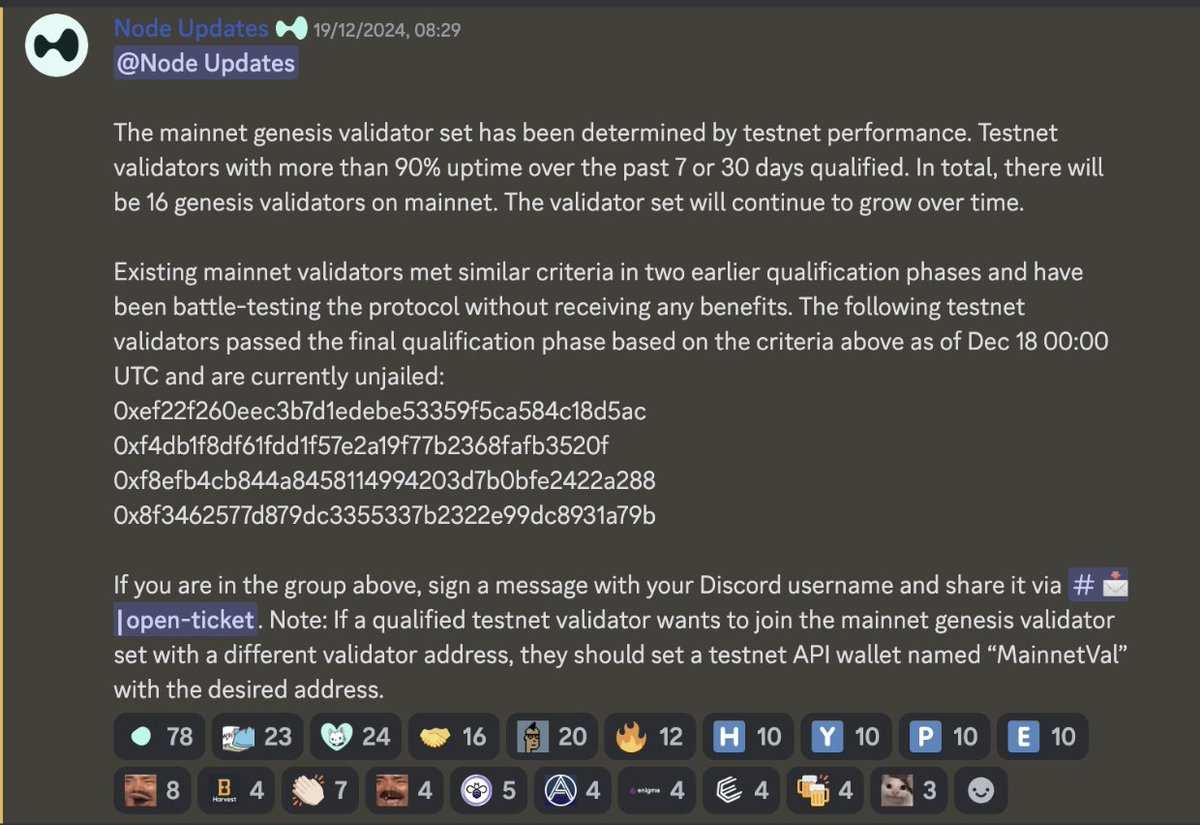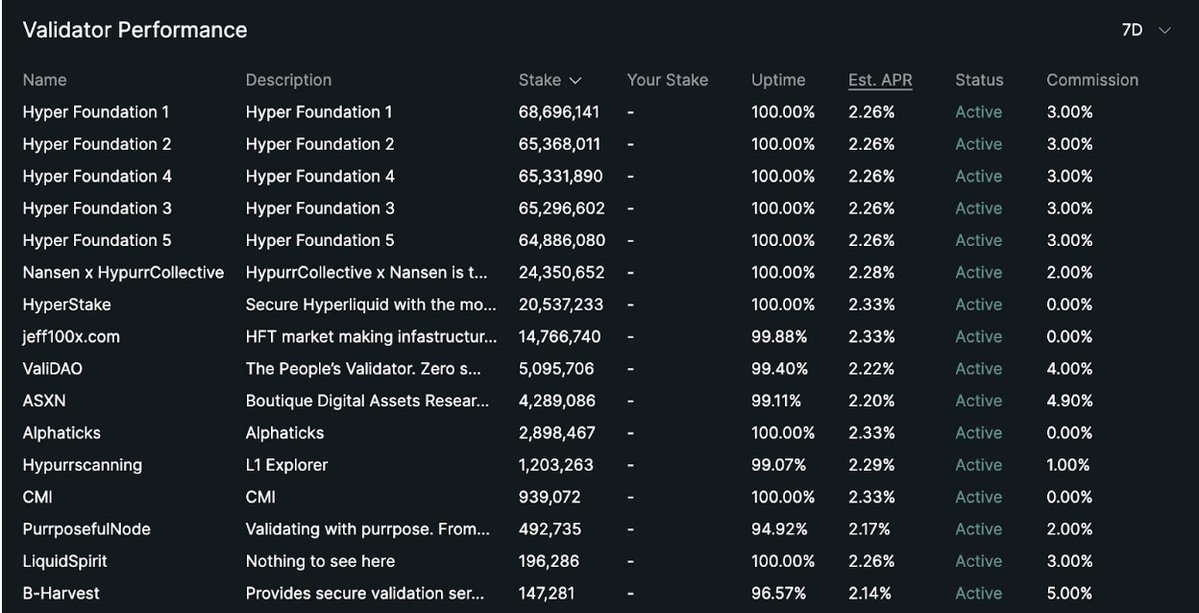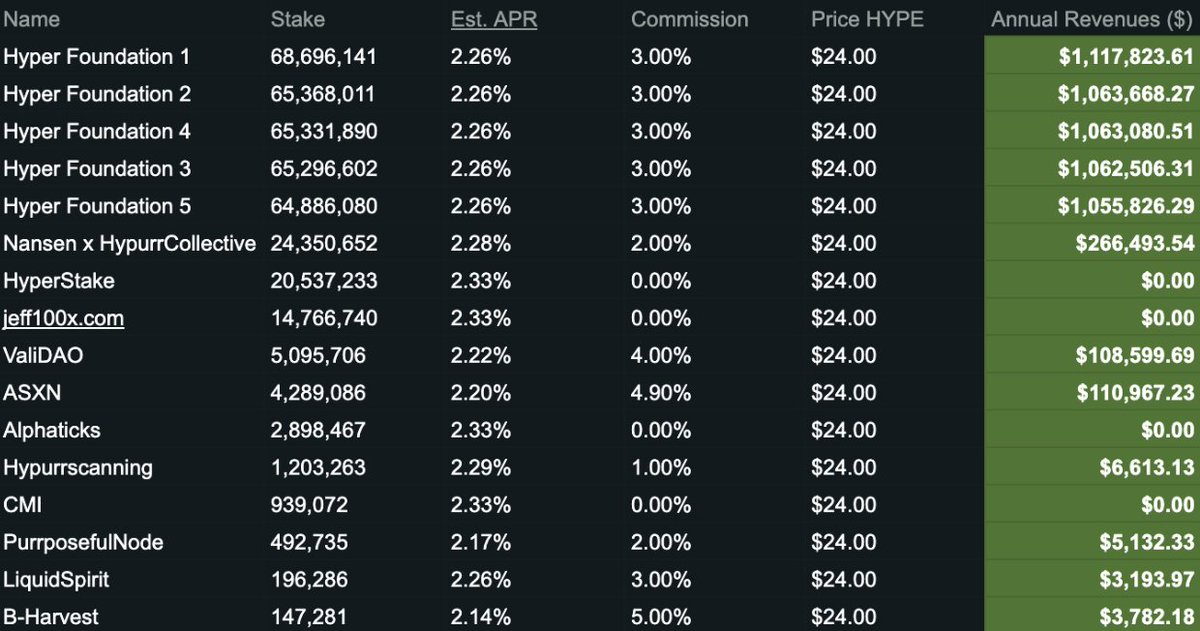The team still needs to improve several aspects of its infrastructure to truly compete with mainstream L1 blockchains.
Written by: Kam
Translated by: Luffy, Foresight News
This letter is addressed to the Hyperliquid development team, hoping that the team can take the time to review this feedback regarding Hyperliquid blockchain management.
Key Points:
Validators face numerous significant challenges due to the lack of open-source code, insufficient documentation, and reliance on centralized application programming interfaces (APIs), leading to frequent jailings and unstable performance.
Testnet incentives have spawned a black market for HYPE tokens, favoring deals with large holders rather than fair selection of validators.
Mainnet validator rewards are too low to meet high self-collateral requirements, and the degree of decentralization is limited, as 81% of the staked shares are controlled by foundation nodes.
To compete with mainstream L1 blockchains, Hyperliquid must improve transparency, reduce staking centralization, implement a fair validator selection process, and enhance interaction with external validators.
I started engaging with Hyperliquid in December 2023, which is an amazing crypto application. It is user-friendly, offers an excellent user experience, and provides some unique features, such as vaults and the renowned HLP. Currently, the assets managed by HLP exceed $350 million, and anyone can participate in Hyperliquid passively.
Seeing how outstanding this platform is and learning that Hyperliquid operates as its own L1 blockchain, I hope Chorus One (a staking solution) can participate as an operator on the Hyperliquid chain. I am an employee of Chorus One, which is one of the largest node operators in the field. Chorus One has been very active in the proof-of-stake industry since 2018.
After being whitelisted on October 17 last year, Chorus One joined the Hyperliquid testnet. I want to share our overall experience on the testnet with the Hyperliquid engineering team, as we have yet to have the opportunity to communicate with them even after nearly three months of joining the testnet.
During this time, we witnessed one of the most successful token launches of 2024: the launch of the HYPE token. At the same time, we experienced a testnet environment that was both interesting and challenging. I would like to mention some observed issues, hoping that these can be addressed in the coming days, weeks, or months.
Testnet Experience
So far, the experience on the testnet has been quite challenging. Operators have almost no knowledge of how to run nodes, and the available resources are very limited. Besides that, we are basically exploring in the dark, and we have encountered multiple issues, including the following:
Frequent Jailings with Unknown Reasons
Initially, we were jailed multiple times without understanding the reasons. Due to the lack of open-source code, it was impossible to accurately assess the causes. The only thing we could do was communicate with other validators on Discord and speculate about the reasons together. After talking to several validators, we found that everyone was frequently jailed and was also unclear about the reasons.
Node Location
Later, we discovered that the jailing issue might be because we were not running nodes in Tokyo. Moving the nodes to Tokyo might help. Unfortunately, the team never clearly stated this, and we only realized it after encountering numerous problems.
After moving the nodes to Tokyo, the situation improved somewhat. This is likely because many testnet nodes holding a large amount of staked tokens are also located in Tokyo, allowing our nodes to miss fewer blocks and keep up with the pace. However, even after relocating the nodes, we still faced jailing issues without knowing the exact reasons. This frustration is mainly due to the lack of open-source code.
Reliance on Automatic Unjailing Scripts
We realized that maintaining good uptime on the Hyperliquid testnet depends on the speed at which scripts automatically unjail nodes. The only way to improve uptime is to rely on scripts that can quickly unjail nodes. Validators cannot fully understand or resolve the underlying issues and can only unjail nodes automatically without a deep understanding.
Centralized Hyperliquid API as a Single Point of Failure
There were several instances where our unjailing attempts failed due to Hyperliquid API malfunctions. If the API fails, validators cannot unjail themselves because they must send requests to the Hyperliquid server to unjail.
The team may be aware of this, but this design needs to be reconsidered, as it makes the API a significant single point of failure for the network. If the goal is to build a Byzantine fault-tolerant system, there should not be any nodes with special privileges, such as nodes relying on a centralized API.
Mainnet Validator Selection
Recently, Hyperliquid has selected about 16 validators in the process of decentralizing its validator set. Previously, Hyperliquid was managed by 4 validators from the core team, which drew much criticism. Recently, Hyperliquid took a significant step by expanding the number of validators from 4 to 16.
Regarding the selection of validators, 4 validators were announced through a post on Discord:

These 4 validators are Validao, Bharvest, Hypurrstake, and Prrposefulnode. They were selected based on uptime, having successfully maintained over 90% uptime in the past 7 or 30 days.
This is an impressive achievement for many reasons. The main reason is that validator performance is also affected by external factors, such as Hyperliquid API malfunctions, jailing issues, and continuous binary crashes, all of which have a significant impact on performance.
In addition to these 4 validators selected based on testnet performance, 5 validators from the Hyperliquid Foundation are also operating on the mainnet. Additionally, 7 other validators were selected for the mainnet, but the reasons for their selection have not been publicly disclosed.
Subsequently, a black market for HYPE testnet tokens began to emerge.
Initially, there were 50 validators on the Hyperliquid testnet. At first, specific entities were whitelisted to join the testnet, but on December 12, validators were completely opened up.
The conditions were simple: 10,000 HYPE testnet tokens were required to register as a validator. However, to become an active validator, one must rank among the top 50; otherwise, the validator would be inactive.
This led to a surge in the price of HYPE testnet tokens. Initially, the price rose to over 3,000 testnet USDC, and a few days later, it even reached over 28,000 testnet USDC. As of the writing of this article, the current token price is about 700 testnet USDC.
Unfortunately, the faucet only dispenses 100 testnet USDC every 4 hours. To rank among the top 50 active validators on the testnet, one currently needs over 528,747 HYPE testnet tokens. Assuming the token price is 700 testnet USDC each and relying solely on the faucet for USDC, the calculation is as follows:
Days Required = (528747×700)÷(100×6) = 616871.5 days
This means that relying solely on the faucet to obtain the required HYPE testnet tokens to become an active validator on Hyperliquid would take approximately 616,871.5 days, or 1,690 years.
However, those who received HYPE airdrops on the mainnet also received an equivalent amount of tokens on the testnet. This created opportunities for validators to collaborate with these community members, allowing them to stake testnet HYPE tokens with validators to secure a place in the active set.
At the same time, this situation also gave holders of testnet HYPE tokens other ideas. Given the fierce competition to join the testnet validator set, many validators are eager to acquire as many HYPE testnet tokens as possible. As a result, a black market emerged, where large holders of testnet HYPE tokens began selling tokens to validators in exchange for real USDC on the mainnet.

I have never seen such a chaotic situation. Although the Hyperliquid team clearly disapproves of these practices, they are fully capable of addressing this issue. One possible solution is to implement a proper validator selection process on the testnet.
In most other proof-of-stake networks, the core team usually shares a form that any validator can fill out to express their willingness to run the chain. The team then reviews these applications and conducts preliminary screening based on various criteria, such as the validator's experience running nodes, past contributions, community involvement, or other factors.
This group of preliminarily selected validators can contribute to the testnet and work closely with the engineering team to provide feedback, ensuring everything runs smoothly. We have made multiple attempts to provide feedback, but to date, we have been unsuccessful.
Mainnet and Decentralization
As mentioned earlier, the current validator set on the Hyperliquid mainnet consists of 16 validators, which can be viewed here: https://app.hyperliquid.xyz/staking.
Among them, 5 are from the Hyperliquid Foundation. 4 are selected based on testnet performance, maintaining over 90% uptime. 7 are selected by the Hyperliquid team themselves.

Out of the 404,495,250 HYPE tokens that have been staked, approximately 329,578,724 HYPE tokens are staked in foundation nodes, accounting for about 81.4% of the total staked share. We know little about HyperBFT, but assuming it operates as a Byzantine fault-tolerant system, the core assumption of most BFT systems is that no more than 33% of the voting power can act maliciously. If a single entity controls one-third of the staked shares, they can halt the blockchain. If they control two-thirds of the staked shares, they can take complete control of the network.
The Hyperliquid Foundation initially staked 60 million HYPE tokens for each foundation node. However, many HYPE holders also chose to stake at foundation nodes, which is detrimental to decentralization. The team should engage more with the community to encourage a more distributed staking distribution.
There are three potential solutions:
Promote to the community the importance of staking with external validators to enhance the security and decentralization of the chain.
Implement a 100% commission rate for foundation nodes to incentivize users to stake with external validators, promoting decentralization.
Redistribute the foundation's staked shares to external validators, which is a common practice among most chains.
Distributing staked shares to external validators also helps them become more economically sustainable. Hyperliquid is a blockchain focused on high throughput, and the infrastructure costs of running nodes (especially in Tokyo) can be quite high. Currently, validators at the bottom earn between $3,000 and $5,000 per year, which is insufficient to cover their costs. Particularly challenging is the requirement to stake 10,000 HYPE tokens (approximately $250,000 at current prices) on the mainnet to validate.

Currently, users interact with Hyperliquid by cross-chain transferring USDC from Arbitrum to the Hyperliquid chain. After reviewing the contracts of the cross-chain bridge, it appears that the bridge is still managed by 4 validators. These validators do not seem to be associated with the chain's consensus mechanism or the 16 validators on the mainnet.

Hyperliquid has a great product, but the team still needs to improve several aspects of its infrastructure to truly compete with mainstream L1 blockchains.
Some improvement measures are as follows:
Listen to validator feedback. While the team's current approach of working independently and not interacting with many external parties has been effective in building their Perp product, validators are the backbone of an L1 blockchain. Listening to their feedback is equally important to ensure everything runs smoothly.
Open-source the code. This will help validators better understand the issues they face when running nodes on the Hyperliquid chain and will also help users trust the product. Open-source code can provide validators with more insight into the architecture and consensus algorithm. Currently, information about HyperBFT is very limited, and open-sourcing can provide the much-needed transparency and understanding.
Create a proper validator selection process to eliminate the black market for HYPE testnet tokens. Selecting validators based on uptime is a fair method, but achieving good uptime should also be fair. It should not depend on external factors such as having connections to obtain testnet tokens, purchasing testnet tokens, or relying on the uptime of the Hyperliquid API.
Overall, Hyperliquid can compete with mainstream L1 blockchains without major changes. The main focus should be on interacting more with external parties and considering their feedback. I look forward to seeing how things develop in the coming weeks and months, and our team is always ready to provide assistance and feedback. Wishing the Hyperliquid team all the best!
免责声明:本文章仅代表作者个人观点,不代表本平台的立场和观点。本文章仅供信息分享,不构成对任何人的任何投资建议。用户与作者之间的任何争议,与本平台无关。如网页中刊载的文章或图片涉及侵权,请提供相关的权利证明和身份证明发送邮件到support@aicoin.com,本平台相关工作人员将会进行核查。




